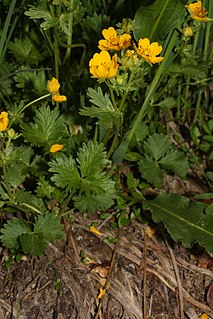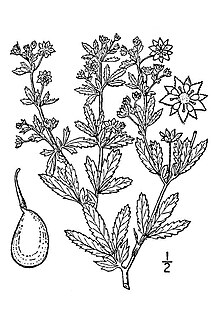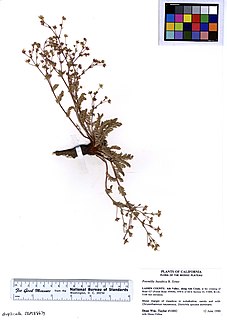
Potentilla is a genus containing over 300 species of annual, biennial and perennial herbaceous flowering plants in the rose family, Rosaceae.

Dasiphora fruticosa is a species of hardy deciduous flowering shrub in the family Rosaceae, native to the cool temperate and subarctic regions of the northern hemisphere, often growing at high altitudes in mountains. Dasiphora fruticosa is a disputed name, and the plant is still widely referenced in the horticultural literature under its synonym Potentilla fruticosa. Common names include shrubby cinquefoil, golden hardhack, bush cinquefoil, shrubby five-finger, and widdy.

Drymocallis arguta, commonly known as the tall cinquefoil, prairie cinquefoil, or sticky cinquefoil, is a perennial herbaceous plant native to North America. It was formerly included with the typical cinquefoils in the genus Potentilla.

Potentilla recta, the sulphur cinquefoil or rough-fruited cinquefoil, is a species of cinquefoil. It is native to Eurasia but it is present in North America as an introduced species, ranging through almost the entire continent except the northernmost part of Canada and Alaska.
Potentilla biennis is a species of cinquefoil known by the common names biennial cinquefoil and Greene's cinquefoil. It is native to western North America from northwestern Canada to the southwestern United States, where it grows in moist habitat. This is an annual or biennial herb producing an erect stem up to 70 centimeters tall from a taproot. It is hairy and glandular in texture. The hairy leaves are each divided into three toothed, oval leaflets each up to 3 centimeters long. The inflorescence is a cyme of several flowers. Each flower has five oval yellow petals 1 or 2 millimeters long and five triangular sepals which are slightly longer. The fruit is a minute whitish achene.

Potentilla diversifolia or Potentilla × diversifolia is a species of flowering plant in the Rose Family (Rosaceae) known by the common names varileaf cinquefoil, different-leaved cinquefoil, and mountain meadow cinquefoil.

Potentilla flabellifolia is a species of cinquefoil known by the common names high mountain cinquefoil, fanleaf cinquefoil and fan-foil.
Potentilla grayi is a species of cinquefoil known by the common name Gray's cinquefoil.
Potentilla millefolia is a species of cinquefoil known by the common names cutleaf cinquefoil and feather cinquefoil. It is native to Oregon, Nevada and eastern California, where it grows in moist mountain meadows and similar habitat. The plant produces a basal rosette from a taproot, then a decumbent stem up to about 20 centimeters in maximum length. The elongated leaves are made up of several overlapping pairs of deeply lobed leaflets. The inflorescence at the tip of the stem is a cyme of a few flowers, each with usually five yellow petals under a centimeter long.

Potentilla morefieldii is a species of cinquefoil known by the common name Morefield's cinquefoil. It is endemic to eastern California, where it is known from just a few occurrences in the White Mountains. It grows in rocky habitat such as talus in alpine climates. This cinquefoil was considered part of the Potentilla drummondii complex until 1992, when it was separated and elevated to species status. This is a small tufted plant with hairy or woolly foliage. The leaves are each made up of several overlapping pairs of lobed leaflets which are green and rough-haired on the upper surfaces and white and woolly-haired underneath. The inflorescence is a cyme of up to 15 flowers with bright yellow petals.

Potentilla newberryi is a species of cinquefoil known by the common name Newberry's cinquefoil. It is native to the Pacific Northwest of the United States from Washington to the northeastern Modoc Plateau in California and Nevada.

Potentilla norvegica is a species of cinquefoil known by the common names rough cinquefoil, ternate-leaved cinquefoil, and Norwegian cinquefoil. It is native to Europe, Asia, and parts of North America, and it can be found elsewhere as an introduced species.

Potentilla pensylvanica is a species of cinquefoil known by the common names Pennsylvania cinquefoil and prairie cinquefoil and in the language Shoshoni, it goes by the name Ku'-si-wañ-go-gǐp. It is native to much of northern and western North America, including most of Canada and the western half of the United States. P. pensylvanica grows in many types of habitat. The plant is quite variable in appearance. It may be small and tuftlike or slender and erect. The leaves are divided into a few leaflets which are deeply lobed and have hairy undersides. The inflorescence is a cluster of several flowers, each with five yellow petals a few millimeters in length. The flower is 3 to 5 mm wide. P. pensylvanica grows in elevations between elevations 2700 to 3800 meters.
Potentilla pseudosericea is a species of cinquefoil known by the common names silky cinquefoil and Mono cinquefoil. It is native to the Sierra Nevada of California and mountain ranges just to the east, where its distribution extends into Nevada. It grows in rocky mountainous habitat. It is a small plant forming mats or tufts in rock cracks and talus, its short stem growing from a caudex. The leaves are generally palmate, divided into five leaflets. The leaflets are deeply lobed along the edges and woolly in texture, coated in white or silvery hairs. The inflorescence is a cluster of a few yellow flowers with petals around 3 millimeters long each.

Potentilla rivalis is a species of cinquefoil known by the common names brook cinquefoil and river cinquefoil. It is native to much of North America, including the southern half of Canada and the western and central United States. It grows in moist habitat, sometimes in disturbed areas. It is an annual or biennial herb producing upright stems up to half a meter tall from a taproot. The hairy leaves are divided into three to five leaflets which are lance-shaped to oval and lined with teeth. The inflorescence is a cluster of several flowers with tiny yellow petals no more than 2 millimeters long on a calyx of pointed sepals and bractlets which are slightly longer.
Potentilla wheeleri is a species of cinquefoil known by the common name Kern cinquefoil or Wheeler's cinquefoil. It is native to the Sierra Nevada and nearby ranges of California and it has been reported from Arizona and Baja California. Its habitat includes moist areas in mountainous regions. This tuftlike plant produces spreading, decumbent stems with leaves sometimes arranged in a rosette about the caudex. The hairy stems reach a maximum length near 25 centimeters. The rough-haired leaves are palmate, each divided into five wedge-shaped leaflets which are lined or tipped with teeth. The inflorescence is a cyme of several flowers with yellow petals each a few millimeters long.

Potentilla villosa is a species of flowering plant in the rose family, Rosaceae. Its common names include villous cinquefoil, northern cinquefoil, and hairy cinquefoil. It is native to northwestern North America, where its distribution extends from Alaska to Alberta to Oregon. There are records from eastern Asia.

Potentilla basaltica is a species of flowering plant in the rose family known by the common names Soldier Meadows cinquefoil and basalt cinquefoil. It is endemic to a small area of the Modoc Plateau and Warner Mountains in northeastern California and northwestern Nevada.

Drymocallis glandulosa, known by the common name sticky cinquefoil and formerly as Potentilla glandulosa, is a plant species in the family Rosaceae.














